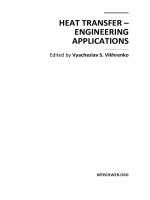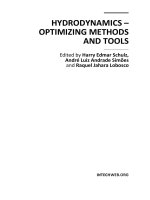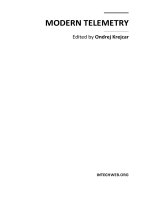Modern Telemetry Part 1 potx
Bạn đang xem bản rút gọn của tài liệu. Xem và tải ngay bản đầy đủ của tài liệu tại đây (2.49 MB, 30 trang )
MODERN TELEMETRY
Edited by Ondrej Krejcar
Modern Telemetry
Edited by Ondrej Krejcar
Published by InTech
Janeza Trdine 9, 51000 Rijeka, Croatia
Copyright © 2011 InTech
All chapters are Open Access articles distributed under the Creative Commons
Non Commercial Share Alike Attribution 3.0 license, which permits to copy,
distribute, transmit, and adapt the work in any medium, so long as the original
work is properly cited. After this work has been published by InTech, authors
have the right to republish it, in whole or part, in any publication of which they
are the author, and to make other personal use of the work. Any republication,
referencing or personal use of the work must explicitly identify the original source.
Statements and opinions expressed in the chapters are these of the individual contributors
and not necessarily those of the editors or publisher. No responsibility is accepted
for the accuracy of information contained in the published articles. The publisher
assumes no responsibility for any damage or injury to persons or property arising out
of the use of any materials, instructions, methods or ideas contained in the book.
Publishing Process Manager Iva Simcic
Technical Editor Teodora Smiljanic
Cover Designer Jan Hyrat
Image Copyright Pongphan.R, 2011. Used under license from Shutterstock.com
First published September, 2011
Printed in Croatia
A free online edition of this book is available at www.intechopen.com
Additional hard copies can be obtained from
Modern Telemetry, Edited by Ondrej Krejcar
p. cm.
ISBN 978-953-307-415-3
free online editions of InTech
Books and Journals can be found at
www.intechopen.com
Contents
Preface IX
Part 1 Sensors 1
Chapter 1 Optical Fiber Sensors 3
Marcelo M. Werneck and Regina Célia S. B. Allil
Chapter 2 Communication Strategies
for Various Types of Swallowable Telemetry Capsules 41
Jin-Ho Cho and Sang Hyo Woo
Chapter 3 Inductively Coupled Telemetry in Spinal
Fusion Application Using Capacitive Strain Sensors 57
Ji-Tzuoh Lin, Douglas Jackson, Julia Aebersold,
Kevin Walsh, John Naber and William Hnat
Chapter 4 Ubiquitous Piezoelectric
Sensor Network (UPSN)-Based
Concrete Curing Monitoring for u-Construction 75
Seunghee Park and Dong-Jin Kim
Part 2 Telemetry Data Mining 93
Chapter 5 Telemetry Data
Mining with SVM for Satellite Monitoring 95
Yosuke Fukushima
Part 3 Biomedical Telemetry 115
Chapter 6 Radio-Telemetry in Biomedical Research -
Radio-Telemetry Blood Pressure Measurements
in Animal Models of Hypertension,
How It Revolutionized Hypertension Research 117
Pierre Dumas, Dan Chiche, Johanne Tremblay,
Ondřej Šeda, Junzheng Peng and Pavel Hamet
VI Contents
Chapter 7 Recent Advances in Telemetry
Monitoring and Analysis for Laboratory Animals 145
Masayoshi Kuwahara
Chapter 8 Advances in Management of
Poultry Production Using Biotelemetry 165
Takoi K. Hamrita and Matthew Paulishen
Chapter 9 Applications of Telemetry
in Small Laboratory Animals
for Studying Cardiovascular Diseases 183
Valdir A. Braga and Melissa A. Burmeister
Part 4 Medical Telemetry 197
Chapter 10 Use of Telemetric EEG in Brain Injury 199
Marcio Furtado, Franco Rossetti and Debra Yourick
Chapter 11 An Efficient Adaptive Antenna-Impedance Tuning
Unit Designed for Wireless Pacemaker Telemetry 223
Francis Chan Wai Po, Emeric de Foucauld,
Jean-Baptiste David, Christophe Delavaud and Pascal Ciais
Part 5 Animal Telemetry 247
Chapter 12 What Is the Proper Method to Delineate
Home Range of an Animal Using Today’s
Advanced GPS Telemetry Systems: The Initial Step 249
W. David Walter, Justin W. Fischer,
Sharon Baruch-Mordo and Kurt C. VerCauteren
Chapter 13 Quantifying Wildlife Home Range Changes 269
Trisalyn A. Nelson
Chapter 14 Use of Telemetry Data to Investigate Home
Range and Habitat Selection in Mammalian Carnivores 281
Marina Silva-Opps and Sheldon B. Opps
Chapter 15 Telemetry as a Tool to Study
Spatial Behaviour and Patterns of
Brown Bears as Affected by the Newly
Constructed Egnatia Highway – N. Pindos - Greece 307
Mertzanis G., Mazaris Ant.,
Sgardelis St., Aravidis El.,
Giannakopoulos Al., Godes C., Riegler S.,
Riegler A. and Tragos Ath.
Contents VII
Chapter 16 Combining Radio and PIT-Telemetry
to Study the Large and Fine-Scale
Movements of Stocked and Wild Brown Trout
(Salmo trutta L.) in a Northeastern Stream, Portugal 329
Amílcar A. T. Teixeira and Rui M. V. Cortes
Chapter 17 Sea Turtle Research 353
I-Jiunn Cheng
Chapter 18 Movements and Habitat Use by Lake Sturgeon
(Acipenser fulvescens) in an Unperturbed Environment:
A Small Boreal Lake in the Canadian Shield 371
Terry A. Dick, D. Block and Dale Webber
Chapter 19 Radiotracking of
Pheasants (Phasianus colchicus L.):
To Test Captive Rearing Technologies 403
Marco Ferretti, Francesca Falcini, Gisella Paci and Marco Bagliacca
Chapter 20 The Use of Acoustic Telemetry in
South African Squid Research (2003-2010) 423
Nicola Downey, Dale Webber, Michael Roberts,
Malcolm Smale, Warwick Sauer and Larvika Singh
Part 6 Military Telemetry 441
Chapter 21 Error Separation Techniques Based
on Telemetry and Tracking Data for Ballistic Missile 443
Huabo Yang, Lijun Zhang and Yuan Cao
Preface
Telemetry problematic is based on knowledge of various disciplines like Electronics,
Measurement, Control and Communication along with their combination as
Computer Networks etc. This fact leads to a need of studying and understanding of
these principles before the usage of Telemetry on selected problem solving. Spending
time is however many times returned in form of obtained data or knowledge which
telemetry system can provide.
Usage of telemetry can be found in many areas from military through biomedical to
real medical applications. Modern way to create a wireless sensors remotely connected
to central system with artificial intelligence provide many new, sometimes unusual
ways to get a knowledge about remote objects behaviour.
This book is intended to present some new up to date accesses to telemetry problems
solving by use of new sensors conceptions, new wireless transfer or communication
techniques, data collection or processing techniques as well as several real use case
scenarios describing model examples.
The book is split to several sections containing one or more chapters. The text starts
with a first section “Sensors” (contain 4 chapters) describing new sensor architectures,
communication strategies between them as well as description of same modern ways
to develop sensors.
Second section “Telemetry Data Mining” introduces problems related to telemetry,
satellite, autonomy, etc. This section contains one very well structured chapter.
Telemetry Use Cases focused on the theme of biomedical, medical, animal as well as
military, are considered in following four sections containing the rest 16 chapters.
These chapters deals with many real cases of telemetry issues which can be used as a
cookbooks for Your own telemetry related problems.
Ondrej Krejcar, Ph.D.
VSB - Technical University of Ostrava,
Faculty of Electrical Engineering and Computer Science,
Department of Measurement and Control,
Centre for Applied Cybernetics,
Poruba, Czech Republic
Part 1
Sensors
1
Optical Fiber Sensors
Marcelo M. Werneck
1
and Regina Célia S. B. Allil
1,2
1
Federal University of Rio de Janeiro-Instrumentation and
Photonic Laboratory-Electrical Engineering Program-COPPE
2
Brazilian Army Technology Center-Biological Defense Laboratory-Chemical,
Biological and Nuclear Defence Division
Brasil
1. Introduction
Telemetry is a technology that allows remote measurement and monitoring of data. It
normally refers to one-way direction of information, that is, from the sensor to the
interrogation system or data logger system. Telemetry could be defined as a sub-class of
telecom, a more complex way of exchanging information such as Internet, telephone calls or
video transmission.
Telecommand, the counterpart of telemetry, occurs when the remote systems require remote
instructions and data to operate, which means that the information goes on the other
direction.
Telemetry finds applications in aerospace, automotive, consumer, engineering, industrial
manufacturing, medical, military, electric power industry etc.
Although the term telemetry commonly refers to wireless data transfer mechanisms (e.g.
using radio or infrared systems), it also encompasses data transferred over other media,
such as a telephone or computer network, optical link or other wired communications.
In the applications mentioned above and particularly in the electric power industry, we find
normally protocols that can be either bidirectional or mono directional, such as Fieldbus, RS-
485, Ethernet, 4-20 mA, 0-10 V, all working in a twisted-pair basis. These protocols, although
being among us for many decades, have disadvantages, particularly when applied to the
electric power industry. One of these disadvantages is that data transmitted through electric
wires normally need electric energy at the sensor end, or in other words, the transducer
needs to be powered in order to measure and transmit data. However, it occurs that
sometimes providing electric energy at the sensor location is difficult for it could be far
away from any appropriated power supply. This happens in long high voltage transmission
lines or along pipe-lines or in deep ocean, for instance. The other problem with these
protocols is that they electrically connect the sensor location with the interrogation location.
The main consequence of this is that short circuits due to malfunctioning or atmospheric
discharges can easily be transferred to the operation room and furthermore putting the
substation personnel and equipment at risk.
With the invention of the practical optical fiber in the 70´s the world watched a boom in the
telecommunication technology. In the 80´s, with the popularity of optical fiber technology,
scientists started to develop a new class of sensors and transducers: the optical fiber sensors.
They came offering many advantages over the other technologies and soon started to be
applied in telemetry with very good return in costs, maintenance and efficiency.
Modern Telemetry
4
In conclusion, when it comes to telemetry, optical fibers perform telemetric measurements at
distances much longer than conventional telemetry protocols and media. Additionally, due
to its virtually infinite capacity to multiplex, one can mix different kinds of signals in one
single fiber therefore saving many kilometers of copper wires, which is also welcome by the
maintenance personnel.
In this article we will concentrate on applications of telemetry over optical fiber and on
optical fiber sensors which encompass telemetry and sensor in one single media.
2. Optical fiber sensors
Optical fiber sensors (OFS) came just after the invention of the optical fiber in the 70’s. At the
beginning of this era, optical devices such as laser, photodetectors and the optical fibers
were very expensive, adequate only to the already saturated telephone network in which
companies would pay any price to transmit more information and more telephone calls.
With the great diffusion of the optical fiber technology in the 80´and on, optoelectronic
devices became less expensive, what favored their use in OFS.
OFS can be applied in many branches of the industry but we will concentrate here their
applications through our experience in the electric power industry.
In this area, the operators need to measure and monitor some important physical
parameters that include:
Strain (µє)
Vibration of structures and machines
Electric current (from A to kA)
Voltage (from mV to MV)
Impedancy (µΩ)
Leakage current of insulators (µA to mA)
Temperature
Pressure
Gas concentration
Distance between stationary and rotating or moving parts
Some of these parameters, depending on where they are located, are very difficult or even
impossible to be conventionally monitored because of a well-known paradigm of the electrical
power industry: An electric sensor cannot be close enough to a high potential in order to break
the electric rigidity of the air, which is about 1 kV/cm. This would cause a short circuit when
the current would flow from high voltage to ground potential by the sensor’s connecting
wires. The best option to avoid this catastrophic effect is the OFS, because the fiber is made of
dielectric materials and therefore it is possible to be placed very close or even touch a high
potential conductor and they do not necessary need electrical power at the sensor location.
OFS can be built using several physical principles and materials. They have specific
characteristics that are well exploited when applied to the electric power industry and in
this case OFS offer a large number of advantages over conventional sensors. The most
important are:
High immunity to EMI
Electrical insulation
Absence of metallic parts
Local electrical power not required
Lightweight and compactness
Optical Fiber Sensors
5
Easy maintenance
Chemically inert even against corrosion
Work over long distances
Several sensors can be multiplexed on the same fiber
The high immunity to electromagnetic interference (EMI) is a strong requirement for sensing
in electromagnetic contaminated environments, e.g. RF-field and high electric and magnetic
fields present in power lines.
The insulation is another special requirement, because as these sensors are inherently
electrically insulated (dielectric) and do not require external power, this means that there is
no electric path from the power line to ground, which means high personnel security.
Therefore the optical fiber sensors can work at high electrical potentials and in potentially
explosive environments.
Optical fibers can be used as sensors by modifying a fiber so that the measurand interferes
on the guided light and modulate light parameters such as intensity, phase, polarization,
wavelength, or transit time of light over the fiber. Sensors that vary the intensity of light are
the simplest, since only a simple source and detector are required.
We can divide OFS in three basic categories: intrinsic, extrinsic and evanescent field based.
Extrinsic fiber optic sensors use an optical fiber, normally multi-mode, to transmit
modulated light from either a non-fiber optical sensor or an electronic sensor connected to
an optical transmitter. In this case the optical fiber is used only to transmit light to and from
the sensor. This kind of sensor sometimes is called hybrid sensor for it enclosures different
technologies such as optics and electronics.
In intrinsic sensors the light does not leave the fiber and the light modulation takes place
inside the fiber. This kind of sensor presents the major benefit to have the ability to reach
otherwise inaccessible places and without the need of electrical energy at the sensing location.
The third category is the evanescent field based sensor. Due to the total internal reflection
phenomenon that occurs in the core-cladding interface of the fiber, the light propagating in
the fiber has two components - an oscillatory field in the core and an exponentially decaying
field in the cladding. The latter field, referred to as the evanescent field, is the key to sensing
and is based on the modulation of the light amplitude in the core of the fiber by the optical
properties of the surrounding medium.
When developing an OFS we can use the fiber for: a) conducting light; b) to be the sensor
itself; and c) for both applications, that is, sensing and conducting light to and from the
sensing area.
An optical fiber is a thin, flexible, transparent glassy filament that acts as a waveguide, or
"light pipe", to transmit light from the light source to the photodetector located at the two
ends of the fiber. They are mainly used for telecom and sensing but find many uses in the
industry, research sciences, medicine, entertainment etc.
By the 70's all telephone cables and microwave links in the planet were already saturated.
The solution came when Charles Kao and George Hockham of the British company
Standard Telephones and Cables (STC) promoted the idea that the attenuation in the
existing optical fibers could be reduced below 20 decibels per kilometer (dB/km), making
fibers a practical communication medium. They proposed that the attenuation in fibers
available at the time was caused by impurities that could be removed by chemical processes.
They correctly and systematically theorized the light-loss properties for optical fiber, and
pointed out the right material to use for such fibers — silica glass with high purity. This
discovery earned Kao the Nobel Prize in Physics in 2009.
Modern Telemetry
6
The crucial attenuation limit of 20 dB/km was first achieved in 1970 by researchers at the
American glass maker Corning Glass Works, now Corning Incorporated. They
demonstrated a fiber with 17 dB/km attenuation by doping silica glass with titanium. A few
years later they produced a fiber with only 4 dB/km attenuation using germanium dioxide
as the core dopant. Such low attenuation allowed optical fiber to be used in telecom from
the 80's until today when the telecom fiber presents an attenuation of only0.25 dB/km.
Although polymeric optical fibers (POF) are around us much longer than silica fibers, only
in the last decade they start to attract attention for LANs and small industrial networks and
their use for sensors has just emerged few years ago. Figure 2.1 shows the different
diameters as comparing POFs with silica fibers.
Fig. 2.1. Relative comparison of diameters in different kinds of fibers. SI-POF=step-index
polymeric optical fiber; PCS=plastic cladding silica fiber; MM Silica=multimode silica fiber;
SM silica=single mode silica fiber; PF-GI-POF=perflorinated graded-index POF. The light
color represents the cladding and dark color the core.
The first report of poly-metil-meta-acrylate (PMMA) POF dates from 1968 when Du Pont
presented a POF with an attenuation of 500 dB/km. From then on several laboratories are
keeping trying to decrease the attenuation in order to apply POF in telecom. Figure 2.2
shows the results of those efforts.
Fig. 2.2. History of the attenuation improvement of PF-GI-POF.
Comparing POF and silica fibers by the attenuation, silica fibers are much better. However,
when constructing a fiber sensor using POF instead of silica, we have some additional
advantages:
Optical Fiber Sensors
7
Maintenance costs
More resistance to strain
Cheaper peripherical components
Easy handling
No need of special skill for splicing and connectorization
Due to their larger diameter, it is simpler to work with open optics and easy handling. POFs
are cheaper than their counterpart as well as the peripheral components and devices, such
as connectors, LEDs and photodetectors. They also present more resistance to strain (larger
modulus of elasticity) which means more reliable networks. Finally, many interfaces can be
built in laboratory what makes the maintenance cost much lower than when dealing with
silica fibers.
Of course POFs have disadvantages too. POF only transmits visible and near infrared light,
so we cannot use the available technology of telecommunications such as 1300 nm and
1500 nm telecom windows. Additionally, POF has a very high attenuation in the visible
spectrum (see Fig. 2.3).
The other issue is the temperature because plastic materials cannot withstand high
temperatures as much as glasses. POFs can operate only up to 70 to 85
o
C. However, some
specials POFs have been developed mainly for harsh environment such as in car networks.
In these applications POFs have to withstand temperatures as much as 150
o
C. Table 1 shows
some examples.
Fig. 2.3. Optical attenuation of silica fibers and POFs.
The attenuation of silica fibers is negligible for sensing distances (around 1 km), but when
using a POF for transmitting light, the first thing to have in mind is the high attenuation the
POF impinges to the light.
3. Case studies
This section will present real applications of OFS and telemetry in the electrical power
industry. The techniques presented here have been tested in the field mainly in high voltage
Modern Telemetry
8
transmission lines, in substation equipments and in hydroelectric generators, all in a
connected-to-the-grid basis.
3.1 Application of POF and ruby for temperature measurement in an electric power
substation
3.1.1 Introduction
Temperature is a very important parameter for the electric power industry because
insulators, copper conductors, iron core of transformers, insulating oil and every equipment
are very sensitive to the temperature which has to be kept under strict control during all
times. Nevertheless, when dealing with high voltage, sometimes one cannot use
conventional electric sensors particularly when working near high voltage areas. This case
reports the development of a temperature sensor system using the fluorescence technique.
The fluorescence effect can be used as an indicator and generate a signal proportional to a
specific parameter need to be monitored. In the same way, fluorescent materials can be used
as sensors. It is well known that the fluorescence decay time of some crystals is proportional
to the temperature. Therefore, one way to build a temperature sensor is by the measurement
of the time constant of the exponential decay that produces a linear relationship with the
temperature.
Optical fibre sensors offer a large number of advantages over conventional sensors such as
high immunity to electromagnetic interference, electrical isolation and the absence of metallic
parts, a strong requirement for sensing in electromagnetic contaminated environments, e.g.
RF/microwave. The sensor probes are inherently electrically insulated system and external
power is not required for their operation, they can work at high electrical potentials and in
potentially explosive environments. It can be made as lightweight, compact, disposable of low
cost and is highly chemically inert even against corrosion.
The fluorescence based sensors offer the advantage of a near-zero background, because the
wavelength of the emitted light is always larger than that of the excitation light, which
makes then in principle much more sensitive and error immune than those that change only
the absorption when the temperature varies [Asada and Yuki, 1994, Grattan and Zhang,
1995]. Previously, experiments with commercial polystyrene fluorescent fibres as
temperature sensor were done [Ribeiro et al., 2003]. Although it features some advantages as
compatibility with standards POFs, a weak fluorescence signal with time-decay < 100 ns
was measured, thus requiring a much complex electronics. Furthermore, the polystyrene
can withstand only up to ~70
o
C thus limiting its usefulness for the electrical energy
industry. Ruby has been used for fluorescence thermometry because it is of low cost, easily
available, POF compatible, requires low cost source (blue or green ultra-bright LEDs), Si-
based photodetection and simple electronics. Additionally it presents strong intensity and
long lifetime of fluorescence signal. The fluorescence peaking at 694 nm wavelength features
a long-decay time of 2-4 ms. Persegol and co-workers [Persegol et al., 1999] described a POF-
based temperature sensor in the range –20
o
C to +120
o
C with an accuracy of 2
o
C for early
detection of faults in medium-voltage (36 kV) substations. They used heavily-doped ruby
powder packaged at the POF end as fluorescent material pumped with a green LED. Two
POF-probe were used, one for pumping the ruby and the other for bringing the fluorescence
back to the photodetector.
In this case study we describe the temperature sensor prototype development based on the
ruby crystal and a one-probe-POF for “low” and “high” temperatures. Low cost passive and
active components as couplers, connectors, adapters, LEDs etc were used. Ruby crystals are
Optical Fiber Sensors
9
geometrically compatible with standard POFs and even after cutting and polishing it
remains at low cost.
3.1.2 The prototype
Fig. 3.1.1 shows a top view picture of the temperature sensor prototype (conditioning
equipment) where the key components are assigned. The LED package was polished almost
reaching the semiconductor chip thus maximizing the light caption. Light launching was made
through butt-coupling the polished LED and a carefully terminated POF. Optical pulses of 32
ms time-width from the LED were generated to pump the ruby crystal at 15.6 Hz. A miniature
1x2 POF-coupler is used to send pump pulses toward the ruby crystal glued at the end of the
POF-probe and to collect the fluorescence toward the Si-photodetector.
Fig. 3.1.1. Top view picture of the temperature sensor prototype (conditioning equipment).
Fig. 3.1.2 shows the picture of the one-POF-probe with 4 mm in diameter. The POF was
terminated at the other end with a standard HP plastic connector. With this configuration, it
can be detached from the conditioning equipment box. The fluorescence response from the
crystal, passing through the same POF, was conveyed into the other port of the coupler. Due
to the back reflections at the many optical interfaces, the fluorescent signal could have been
buried under the intense excitation signal. Thus, in order to avoid a saturation of the
detection stage and to enable the fluorescence response to be detected exclusively, a red
long-pass filter was placed before the Si photodiode. The electrical signal generated from the
photodiode is amplified and processed.
Fig. 3.1.2. Picture of the miniaturised POF-probe with hemispherical ruby crystal.
The field prototype probe (Fig. 3.1.3) was designed to work in the field under 25 kV. The
POF with the ruby crystal is inserted inside the probe up to its tip where it touches the
copper conductor of the coil.
Modern Telemetry
10
Fig. 3.1.3. High voltage probe.
3.1.3 Prototype tests
Fig. 3.1.4 shows in the top the oscilloscope trace of the square shape pump pulses. Bottom trace
shows the fluorescence signal at room temperature exhibiting a clear exponential time-decay.
Fig. 3.1.4. Oscilloscope traces of pump (top) and fluorescent (bottom) light signals at room
temperature (23
o
C).
The exponential decay shown in Fig. 3.1.4 can be expressed as:
P(t) =P
0
exp[-t/τ(T)]
where P(t) is the output light power at a time t, P
0
is the light power at t=0 and τ(T) it the
time-decay constant at temperature T. Fig 3.1.5 shows the measurements of fluorescence
time-decay τ against the temperature T with a typical relaxation time of about 5.0 ms.
Fig. 3.1.5. Fluorescence time-decay against the temperature.
Optical Fiber Sensors
11
From the straight line slope shown in Figure 3.1.5 the sensitivity is calculated to be
22.5 μs/
o
C corresponding to an estimated temperature resolution of ~1
o
C. A sensitivity of
9 μs/
o
C has been reported in the literature. However, our sample presented a larger
sensitivity probably due to the re-absorption phenomena [Persegol et al., 1999].
Plastic materials cannot withstand high temperatures as much as glasses. Standard POFs
usually can operate up to 70 to 85
o
C. However, some special POFs have been developed
mainly for harsh environment as in car networks applications. Some of those “high-
temperature” POFs had been disclosed in the literature but still impose severe limitations
for temperature sensing [Ribeiro et al., 2003].
Table 1 shows the attenuation given by the manufacturer for three POFs (Mitsubishi Rayon
Company) corresponding to centre wavelengths of blue/green LEDs and ruby R-line
(694 nm).
Fiber Type 470 nm 525 nm 694 nm
EH4001 (datacom-grade) ~ 0.10 dB/m ~ 0.10 dB/m > 0.40 dB/m
DH4001 (heat-resistant, 115
o
C) 0.95 dB/m 0.48 dB/m 0.40 dB/m
FH4001 (heat-resistant, PC core, 125
o
C) 4.00 dB/m 2.70 dB/m 1.30 dB/m
Table 1. Attenuation of three POFs at some key wavelengths. PC = polycarbonate.
From Table 1 one can see that the EH4001 POF-probe attenuation is the same despite the use
of blue or green LED regarding a maximum temperature of 85
o
C for which this POF can
withstand.
Table 2 shows comparatively the attenuations for 10m of POF-probe length when a
maximum temperature of 110
o
C is allowed to be reached.
470 nm (pump) + 694nm
(fluorescence)
525 nm (pump) + 694nm
(fluorescence)
EH 4001 1.0 + 4.0 = 5.0 dB 1.0 + 4.0 = 5.0 dB
DH4001 9.5 + 4.0 = 13.5 dB 4.8 + 4.0 = 8.8 dB
FH4001 40.0 + 13.0 = 53.0 dB 27.0 + 13.0 = 40.0 dB
Table 2. Attenuation for 10 m of POF-probe for different pump wavelengths.
Fibers type DH4001 and FH4001 can withstand up to 115
o
C and 125
o
C, respectively.
However, our choice as “high temperature” POF-probe was the heat resistant-grade
DH4001 (1 mm core with black XPE jacket) because it features total attenuation of 8.8 dB
that is much smaller than 40.0 dB presented by FH4001 regarding the green LED as the
excitation light source.
3.1.4 Field installation
The system has been installed at the harmonic filter of Furnas Substation in the city of
Ibiúna, State of São Paulo, Brasil to allow the technicians to monitor the temperature in four
points of the coil of this reactor in real time. If the temperature reaches 80
o
C an alarm is
issued in order to shut down the transmission line. Fig 3.1.6 shows one of the four installed
sensors, Fig. 3.1.7 shows the coil with two of the sensors and Fig. 3.1.8 shows the control
software which screen shows the graph of the four temperatures as well as the ambient
temperature.
Modern Telemetry
12
Fig. 3.1.6. One of the four sensors installed on the top of the coil.
Fig. 3.1.7. The reactor coil and the sensors installed.
Fig. 3.1.8. Control software screen showing the graph of the four temperatures as well as the
ambient temperature.
3.1.5 Results
Figures 3.1.9 and 3.1.10 show the graphs of the measurements taken at two different dates.
Optical Fiber Sensors
13
Fig. 3.1.9. Temperature monitored by the four transducers.
Fig. 3.1.10. Temperature monitored during an electric power shortage.
3.1.6 Concluding remarks
Experimental results of a simple and low cost four-point temperature POF sensor prototype
based on time-decay of the ruby fluorescence pumped with blue (or green) ultra-bright LED
are presented. The major drawbacks of polymer optical fibres are their restricted temperature
range and relatively high losses. However many applications do not exceed a temperature of
more than 100
o
C and requires a sensing distance smaller than 10 m. The best choice for
temperatures up to 115
o
C was the DH4001 as the POF-probe pumped with green LED. The
developed prototype is quite compatible with a 1-mm-core silica fibre or a hybrid POF + silica
fibre-probe where the later may be put in contact with the hot surface to be sensed.
3.2 Application of a POF-based current sensor for measuring leakage current in
500 kV transmission line
3.2.1 Introduction
The leakage current of insulators in a high voltage transmission line is due to the increasing
conductive deposited yielded by environment pollution. The more common pollution is the
salt-spray produced by winds in areas close to sea shore. The salt deposit on the insulator
surface offers to the electrical current alternative paths to the ground, thus connecting the
high voltage to ground potential. Although this current is only a few tens of milliamperes,
when multiplied by the total number of insulators located in that particular transmission
line, the total leakage current can reach so high values that can trigger over current
protection devices leading to electrical power line interruption. When an electric arc occurs,
Modern Telemetry
14
it is called “flashover”, leading occasionally to the destruction of the whole insulator
[Kanashiro and Burani, 1996].
An optoelectronic sensor for real time leakage current monitoring of high-voltage (500kV)
power lines insulators was developed as a continuation of a study presented on the 2003 POF
Conference (Werneck et al, 2003). The leakage current drives an ultra-bright green LED. The
optically intensity-encoded data measurement is coupled to a POF and transmitted from the
high potential to ground potential. After demodulation, the RMS value of the leakage current
and waveforms are sent to a remote station using a GPRS code in a cell-phone platform. This
case study shows the sensing system, the telemetry technology and the results obtained.
The continuous monitoring of leakage current levels yields parameters to establish an
operational preventive strategy of cleaning or substitution of insulators placed inside the
area with favorable conditions to flashover occurrence.
Usually, in order to monitor leakage current, it is applied a resistor (Briggs, 1976; Amarh,
2001) or an induction coil (Maraio, 1992). However, these methods need the connection to
potential, allowing electromagnetic interference and risks to personnel. In order to
circumvent this problem it has been proposed the development of an optoelectronic system
using plastic optical fiber (POF) technology. This method has some advantages, such as it
does not suffer electromagnetic interference effect; it is of low cost, light weight and does
not need power supply to work.
With this system in operational status it will bring benefits such as energy losses monitoring
and increasing the grid reliability. It also promotes optimization of insulators washing
causing therefore a reduction of maintenance cost.
3.2.2 System description and methods
The sensor previously developed and presented in the 2003 POF Conference was used for
13.8 kV whereas this same technology is now used for a 500 kV transmission line in the city
of São Luis, State of Maranhão, Brazil. Fig. 3.2.1 shows the schematic diagram of the system.
Fig. 3.2.1. Schematic diagram of the system
The main problem is the insulation of the whole system, since at this so high voltage, nearly
everything conducts, including POFs. Therefore, we should place the sensor at or near
ground potential.
Optical Fiber Sensors
15
The method proposed to monitor the leakage current of high-voltage circuits is based on the
fact that all leakage current flows through all insulator sectors (see Fig. 3.2.1). Therefore if we
measure the current from the last section of the insulator to ground, we are actually measuring
the leakage current and with the sensor connected at a low voltage level. Fig. 3.2.2 shows the
location where the control and transmission box is installed and the location where the sensor
is installed at the insulator chain of a 500 kV transmission line tower.
(a) (b)
Fig. 3.2.2. The arrows show the location where the control and transmission box is installed
and the location where the sensor is installed.
3.2.3 The transducer
The leakage current supplies energy enough to optically power a high efficient blue-green-
LED (Marcou, 1997). The leakage current modulates the LED output power that is
transmitted to the receptor by means of a specially protected POF. The emitted light from
the LED is amplitude and wavelength modulated. In this work it was applied only
amplitude modulation/demodulation technique.
Fig. 3.2.3. Picture of the POF-based leakage current sensor
The optical signal is detected by the receptor circuit, inside the Remote Station that performs
the half cycle demodulation. Fig. 3.2.3 shows pictures of the transducer which was designed
to be connect to the test-insulator. Calibration and measurement procedures of leakage
waveforms were made under controlled laboratory conditions by a salt-spray chamber
aiming to simulate the real conditions of the field.









